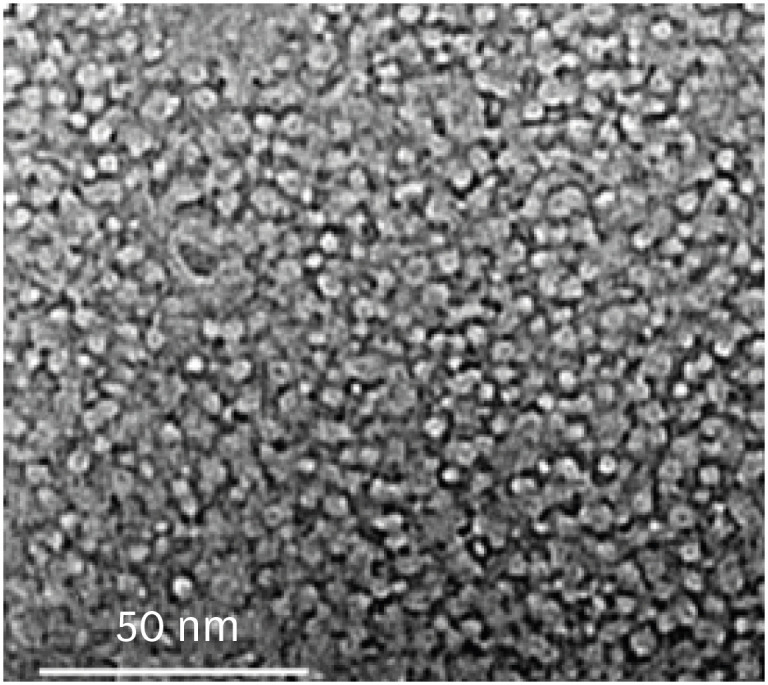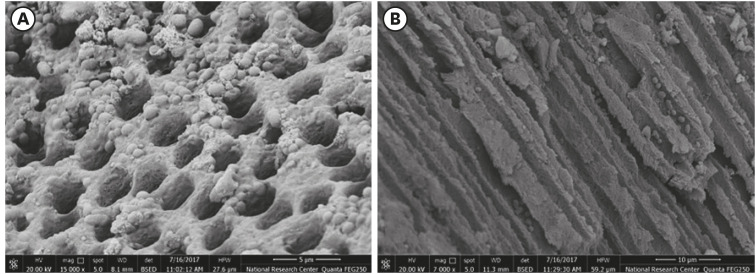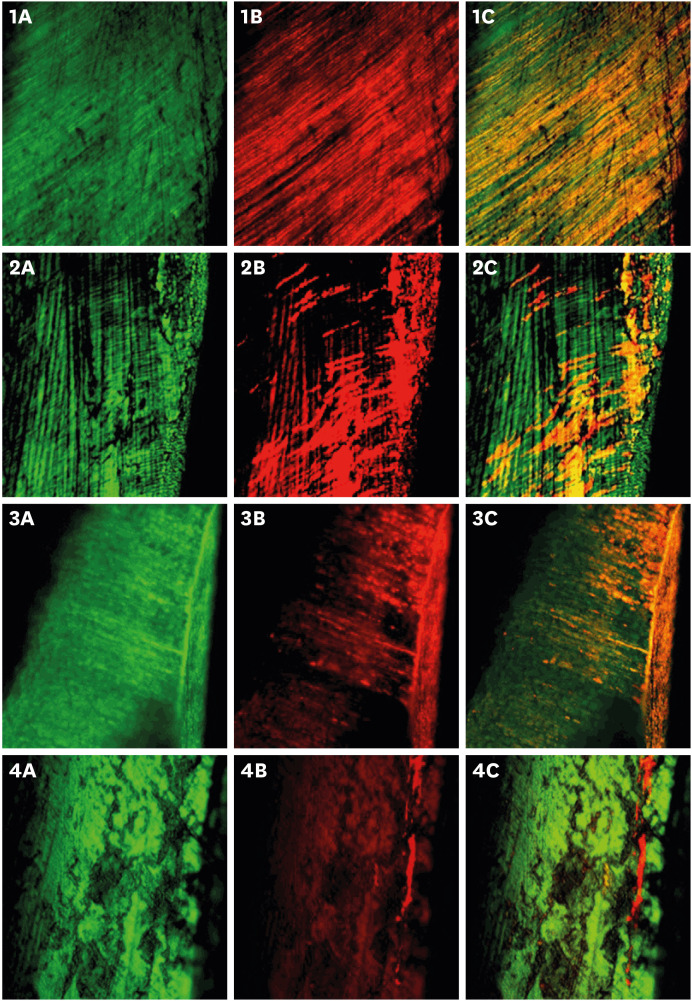Restor Dent Endod.
2021 Nov;46(4):e58. 10.5395/rde.2021.46.e58.
The effect of using nanoparticles in bioactive glass on its antimicrobial properties
- Affiliations
-
- 1Department of Endodontic, Faculty of Dentistry, Ain Shams University, Cairo, Egypt
- KMID: 2548102
- DOI: http://doi.org/10.5395/rde.2021.46.e58
Abstract
Objectives
This study addresses the effect of using nanoparticles (np) on the antimicrobial properties of bioactive glass (BAG) when used in intracanal medicaments against Enterococcus faecalis (E. faecalis) biofilms.
Materials and Methods
E. faecalis biofilms, grown inside 90 root canals for 21 days, were randomly divided into 4 groups according to the antimicrobial regimen followed (n = 20; BAG-np, BAG, calcium hydroxide [CaOH], and saline). After 1 week, residual live bacteria were quantified in terms of colony-forming units (CFU), while dead bacteria were assessed with a confocal laser scanning microscope.
Results
Although there was a statistically significant decrease in the mean CFU value among all groups, the nano-group performed the best. The highest percentage of dead bacteria was detected in the BAG-np group, with a significant difference from the BAG group.
Conclusions
The reduction of particle size and use of a nano-form of BAG improved the antimicrobial properties of the intracanal treatment of E. faecalis biofilms
Figure
Reference
-
1. Haapasalo M, Endal U, Zandi H, Coil JM. Eradication of endodontic infection by instrumentation and irrigation solutions. Endod Topics. 2005; 10:77–102.
Article2. Dahlén G, Samuelsson W, Molander A, Reit C. Identification and antimicrobial susceptibility of enterococci isolated from the root canal. Oral Microbiol Immunol. 2000; 15:309–312. PMID: 11154422.
Article3. Portenier I, Haapasalo H, Ørstavik D, Yamauchi M, Haapasalo M. Inactivation of the antibacterial activity of iodine potassium iodide and chlorhexidine digluconate against Enterococcus faecalis by dentin, dentin matrix, type-I collagen, and heat-killed microbial whole cells. J Endod. 2002; 28:634–637. PMID: 12236305.
Article4. Shuping GB, Ørstavik D, Sigurdsson A, Trope M. Reduction of intracanal bacteria using nickel-titanium rotary instrumentation and various medications. J Endod. 2000; 26:751–755. PMID: 11471648.
Article5. Mohammadi Z. Antibiotics as intracanal medicaments: a review. J Calif Dent Assoc. 2009; 37:98–108. PMID: 19489526.
Article6. Zehnder M, Söderling E, Salonen J, Waltimo T. Preliminary evaluation of bioactive glass S53P4 as an endodontic medication in vitro . J Endod. 2004; 30:220–224. PMID: 15085050.
Article7. Kishen A. Advanced therapeutic options for endodontic biofilms. Endod Topics. 2010; 22:99–123.
Article8. Stoor P, Söderling E, Salonen JI. Antibacterial effects of a bioactive glass paste on oral microorganisms. Acta Odontol Scand. 1998; 56:161–165. PMID: 9688225.
Article9. Shrestha A, Shi Z, Neoh KG, Kishen A. Nanoparticulates for antibiofilm treatment and effect of aging on its antibacterial activity. J Endod. 2010; 36:1030–1035. PMID: 20478460.
Article10. Kishen A, Shi Z, Shrestha A, Neoh KG. An investigation on the antibacterial and antibiofilm efficacy of cationic nanoparticulates for root canal disinfection. J Endod. 2008; 34:1515–1520. PMID: 19026885.
Article11. Yamamoto O. Influence of particle size on the antibacterial activity of zinc oxide. Int J Inorg Mater. 2001; 3:643–646.
Article12. Mortazavi V, Nahrkhalaji MM, Fathi MH, Mousavi SB, Esfahani BN. Antibacterial effects of sol-gel-derived bioactive glass nanoparticle on aerobic bacteria. J Biomed Mater Res A. 2010; 94:160–168. PMID: 20127997.
Article13. Bukhari S, Karabucak B. The antimicrobial effect of bioceramic sealer on an 8-week matured enterococcus faecalis biofilm attached to root canal dentinal surface. J Endod. 2019; 45:1047–1052. PMID: 31160079.
Article14. Allan I, Newman H, Wilson M. Antibacterial activity of particulate bioglass against supra- and subgingival bacteria. Biomaterials. 2001; 22:1683–1687. PMID: 11374470.
Article15. Ma J, Wang Z, Shen Y, Haapasalo M. A new noninvasive model to study the effectiveness of dentin disinfection by using confocal laser scanning microscopy. J Endod. 2011; 37:1380–1385. PMID: 21924186.
Article16. Schaudinn C, Carr G, Gorur A, Jaramillo D, Costerton JW, Webster P. Imaging of endodontic biofilms by combined microscopy (FISH/cLSM - SEM). J Microsc. 2009; 235:124–127. PMID: 19659906.
Article17. Ahlquist M, Henningsson O, Hultenby K, Ohlin J. The effectiveness of manual and rotary techniques in the cleaning of root canals: a scanning electron microscopy study. Int Endod J. 2001; 34:533–537. PMID: 11601771.
Article
- Full Text Links
- Actions
-
Cited
- CITED
-
- Close
- Share
- Similar articles
-
- Antimicrobial properties of nanomolecules: potential candidates as antibiotics in the era of multi-drug resistance
- Silver Nanoparticles as a Smart Antimicrobial Agent
- Histological Observations on Bone Healing with Bioactive Glass in Horizontal Ridge Augmentation: A Report of Four Cases
- In vitro antimicrobial effect of the tissue conditioner containing silver nanoparticles
- THE EFFECT OF BIOACTIVE GLASS AND A RESORBABLE MEMBRANE ON BONE REGENERATION OF THE MANDIBULAR BONE DEFECTS IN RABBIT




